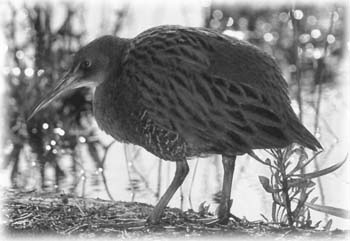![[Metroactive Features]](http://metroactive.com/features/gifs/feat468.gif)
![[Metroactive Features]](http://metroactive.com/features/gifs/feat468.gif)
[ Metro | Metroactive Central | Archives ]
Rail-Roaded
Rallus longirostris obsoletus
By Michael Learmonth
Before the airports, seawalls, salt-evaporation ponds and parking lots, a vast 195,000-acre green carpet blanketed the shores of the San Francisco Bay. Grizzly bears, snowy egret and harbor seals fished along the windy sloughs. Wetland mud teemed with shellfish and crabs. One handful could contain as many as 40,000 living creatures.
It was Club Med for a little shoreline bird called the California clapper rail. With plenty of food and only the occasional hawk or owl to worry about, the clapper rail had it good. It evolved accordingly. Its flight range is about that of a chicken. It is camouflaged with a brightly colored beak and fluffy white breast feathers. It lays its eggs on the ground. Its only defense is to run, but there again, when frightened, the clapper rail is just as likely to stand still in hopes of not being noticed.
When settlers arrived with their muskets, they discovered the bird to which it must have seemed God had taped a sign that said "Eat me." By 1900, the rails were almost gone. They rallied after the Migratory Bird Treaty of 1916 restricted hunting.
Humans no longer eat clapper rail, but animals Homo sapiens introduced into the area find them easy prey. The red fox was introduced by east coast transplants hoping to bring with them the tradition of the English hunt. Erstwhile dumpster divers like Norway rats, skunks and raccoons also wreak havoc on the rail. A habitat splintered into small pieces makes the rail easier to find for these urban scavengers.
The clapper rail got its name from its rapid clattering call. Nesting pairs solidify their bond by blending their clatter so they sound like one bird, an act misty-eyed biologists call a "duet."
Today, the California clapper rail is threatened by habitat loss and everything that comes with human overpopulation. The bird lives only in the Bay Area, the largest estuary on Earth, and was listed as an endangered species in 1970. And in 1992, Joy Albertson, wildlife biologist for the San Francisco Bay National Wildlife Refuge, counted a mere 240 clapper rail remaining.
Today, Albertson reports, the numbers aren't so grim. The clapper rail population is up to about 1,000, and the acquisition of 1,600 more acres of habitat on Bair Island in Redwood City should give it another boost. But can a bird that seems so ill-suited to urban life ever come off the endangered list?
"There are a few clapper rails in the restored area of Bair Island," says Albertson. "We definitely expect them to increase. Chunks of good, large habitats are what is limiting."
A recent study of the rail with radio collars conducted by Albertson illustrates the dangers the little bird faces. Two clapper rail were found killed and buried by a red fox, which also raids rail nests. One rail was killed by a feral cat; another became entangled in an old balloon and ribbon and drowned when the tide came in.
Cecily Harris of the San Francisco Bay Wildlife Society says the best place in the world to see clapper rail is at the Baylands at the end of Embarcadero Road in Palo Alto.
"You can hear them and sometimes see them at high tide," she says. "It's so exciting to see one because there are so few left."
[ Metro | Metroactive Central | Archives ]
This page was designed and created by the Boulevards team.

Dutcher Film Productions
From the May 1-7, 1997 issue of Metro
Copyright © 1997 Metro Publishing, Inc.